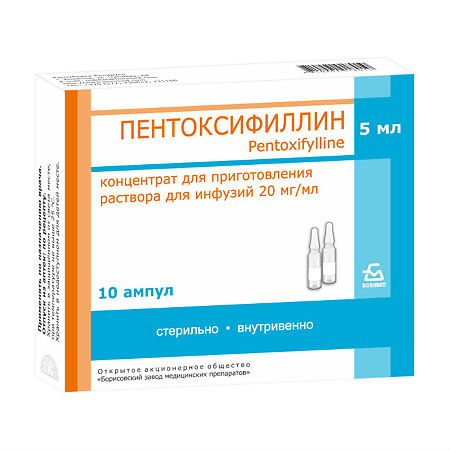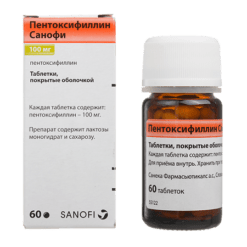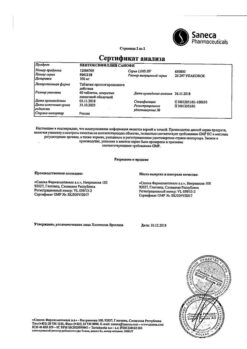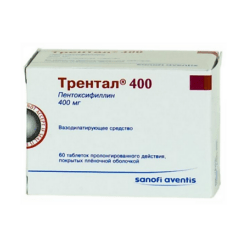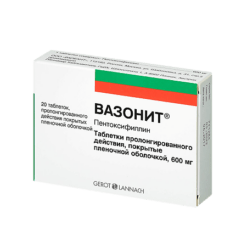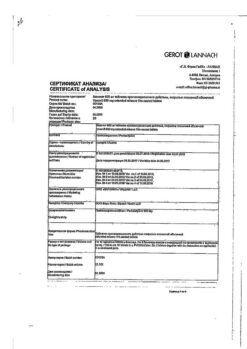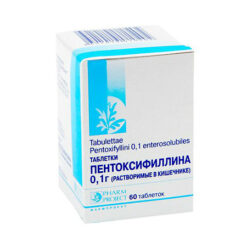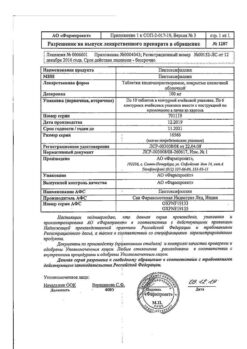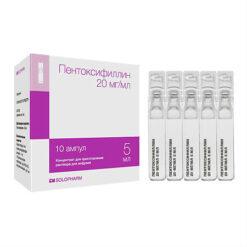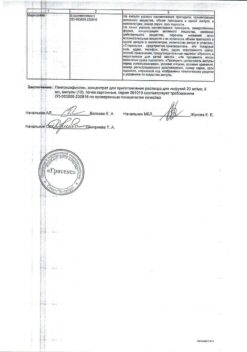No products in the cart.
Pentoxifylline, 20 mg/ml 5 ml 10 pcs
€1.96 €1.78
Description
Pentoxifylline is a drug that improves microcirculation. Angioprotector.
It improves microcirculation and blood rheology, has a vasodilator effect, blocks phosphodiesterase and promotes u-AMP accumulation in cells. Increases the elasticity of the erythrocyte membrane, reduces their adhesion, reduces platelet aggregation and blood viscosity. It blocks adenosine receptors.
Pharmacokinetics
Metabolized by the liver. Several active metabolites are formed during metabolism.
The drug is excreted mainly through the kidneys as metabolites. Less than 4% of the administered dose is excreted in the feces.
In patients with impaired hepatic function the bioavailability of the drug is increased and its T1/2 is prolonged.
Indications
Indications
Stage IIb peripheral circulatory disorders according to the Fontaine classification (“intermittent” claudication): as initial or maintenance treatment when prescribing oral pentoxifylline, in combination with surgical treatment or in the preoperative period, or if surgical treatment is not possible; diabetic angiopathy.
Pharmacological effect
Pharmacological effect
Pentoxifylline is a drug that improves microcirculation. Angioprotector.
Improves microcirculation and rheological properties of blood, has a vasodilating effect, blocks phosphodiesterase and promotes the accumulation of c-AMP in cells. Increases the elasticity of the red blood cell membrane, reduces their adhesion, reduces platelet aggregation and blood viscosity. Blocks adenosine receptors.
Pharmacokinetics
Metabolized by the liver. During metabolism, several active metabolites are formed.
The drug is excreted mainly through the kidneys in the form of metabolites. Less than 4% of the administered dose is excreted in the feces.
In patients with impaired liver function, the bioavailability of the drug increases and its T1/2 lengthens.
Active ingredient
Active ingredient
Pentoxifylline
Composition
Composition
1 ampoule (5 ml) of solution contains:
Contraindications
Contraindications
– acute myocardial infarction;
– massive bleeding;
– cerebral hemorrhage;
– extensive hemorrhage in the retina;
– hemorrhagic diathesis;
– stomach and intestinal ulcers;
– pregnancy;
– breastfeeding;
– children and adolescents up to 18 years of age;
– hypersensitivity to pentoxifylline, other methylxanthine derivatives or components of the drug.
Side Effects
Side Effects
From the digestive system: dry mouth, decreased appetite, intestinal atony, exacerbation of cholecystitis, cholestatic hepatitis.
From the senses: blurred vision, scotoma.
From the cardiovascular system: tachycardia, arrhythmia, cardialgia, progression of angina, decreased blood pressure.
From the hematopoietic organs and hemostasis system: thrombocytopenia, leukopenia, pancytopenia, hypofibrinogenemia; bleeding from blood vessels of the skin, mucous membranes. stomach, intestines.
Allergic reactions: itching, skin hyperemia, urticaria, angioedema, anaphylactic shock.
Laboratory indicators: increased activity of liver transaminases (ALT, AST, LDH) and alkaline phosphatase.
Interaction
Interaction
Pentoxifylline enhances the effect of heparin, fibrinolytic drugs, theophylline, antihypertensive and hypoglycemic agents (both insulin and oral hypoglycemic agents).
Pentoxifylline may enhance the effect of drugs that affect the blood coagulation system (indirect and direct anticoagulants, thrombolytics), antibiotics (including cephalosporins – cefamandole, cefoperazone, cefotetan), valproic acid.
Cimetidine increases the concentration of pentoxifylline in the blood plasma (risk of side effects).
Co-administration with other xanthines may lead to excessive nervous agitation in patients.
Overdose
Overdose
Symptoms: nausea, dizziness, cyanosis, tachycardia, marked decrease in blood pressure, redness of the skin, increased body temperature (chills), agitation, areflexia, tonic-clonic convulsions, vomiting “coffee grounds,” arrhythmias, loss of consciousness.
Treatment: symptomatic. Particular attention should be paid to maintaining blood pressure and respiratory function. Convulsions are relieved by administering diazepam. Urgent measures in case of severe anaphylactic reactions (shock):
when primary symptoms appear (sweating, nausea, cyanosis), immediately stop taking the drug;
in addition to other necessary measures, ensure a lower position of the head and upper body and provide freedom for breathing;
urgent medical measures: administer intravenous epinephrine (adrenaline). If necessary, the administration of epinephrine can be repeated.
Storage conditions
Storage conditions
In a dry place, at a temperature not exceeding 30°C.
Shelf life
Shelf life
2 years
Manufacturer
Manufacturer
Borisov Medical Preparations Plant, Belarus
Additional information
| Shelf life | 2 years |
|---|---|
| Conditions of storage | In a dry place, at a temperature not exceeding 30 ° C. |
| Manufacturer | Borisov Medical Preparations Plant, Belarus |
| Medication form | solution for injection |
| Brand | Borisov Medical Preparations Plant |
Other forms…
Related products
Buy Pentoxifylline, 20 mg/ml 5 ml 10 pcs with delivery to USA, UK, Europe and over 120 other countries.

